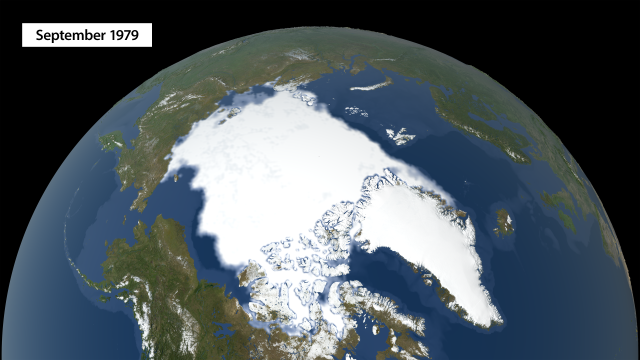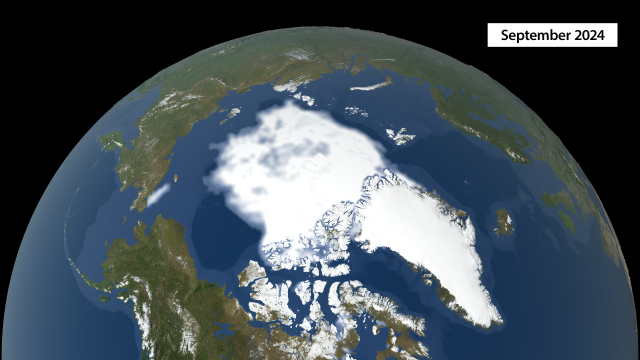Observed Changes in the Arctic
Climate change is contributing to major reductions in sea and land ice, more extreme events on land, and warmer oceans in the Arctic. This page describes observed changes in the Arctic. For more information about what these changes mean for communities, please visit the Community Impacts page.
Explore the sections to learn more about these changes:
Melting Ice and Thawing Permafrost
Reductions in Sea Ice Extent and Thickness
Part of the Arctic Ocean is covered by ice all year. The area covered by ice is typically smallest in September after the summer melting season. The annual minimum extent of Arctic sea ice has decreased over time, mostly due to changes in the melting season that are driven by warmer temperatures. Evidence suggests that the melting season is now longer, with the ice starting to melt earlier in the year and freezing later than it used to.1
The age of sea ice is also important. Ice that has accumulated over many years is generally thicker and stronger than younger ice. A loss of older ice suggests the Arctic ice cover is getting thinner.2 Thinner ice is more likely to melt even more.
Learn more about EPA's Sea Ice Indicator.
Thawing Permafrost
Permafrost is rock or soil with ice that stays frozen for two or more years, which usually lies below a layer of soil that freezes and thaws every year.3 This layer can be a few feet to several thousand feet thick and is mainly found in or near the Arctic. In Alaska, about 80 percent of the ground has permafrost underneath it.4 Permafrost is affected by the temperature at the ground surface and shallow depths, and the seasonal timing, amount and extent of snow cover.5 Higher temperatures in Alaska, caused by climate change, lead to thawing permafrost in some areas. This can in turn cause large impacts on people and the environment, like land erosion and damage to buildings and transportation infrastructure.
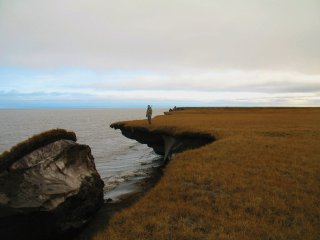
Thawing permafrost can also make warming worse. When permafrost thaws, it can allow organic matter to decompose, releasing methane and other greenhouse gases, which further contribute to warming. The Intergovernmental Panel on Climate Change (IPCC) estimates that Arctic and boreal permafrost (in the northern regions just south of the Arctic) contains nearly twice the amount of carbon already stored in the atmosphere.6
Learn more in EPA's Permafrost Climate Change Indicator.
Freeze-Thaw Conditions
Alaska’s unfrozen days have increased at an average rate of about four days per decade.7 In the Arctic, many features, like sea ice and permafrost, need freezing temperatures (below 32°F). Changes in temperature can impact when lakes and rivers freeze and thaw.8 Changes in the number and timing of freezing days can affect ecosystems, communities, and the economy in different ways.
Learn more in EPA's Freeze-Thaw Conditions Climate Change Indicator.
Melting Glaciers and Ice Sheets
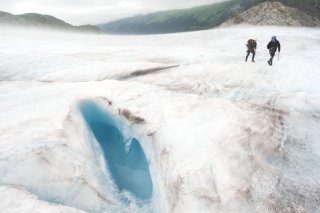
Warming temperatures are causing ice sheets and glaciers to melt, which is contributing to rising global sea levels. Melting glaciers are expected to have a big impact on local ecosystems and food webs and the communities that rely on them.9
The loss of land-based ice in the Arctic has accelerated in recent decades. Since at least 1972, the Arctic has been the main source of global sea-level rise.10 Since 1992, Greenland, which is covered by thousands of square miles of ice sheets, has been losing its ice sheets at an average of about 175 billion metric tons of ice per year.11 This makes Greenland the largest contributor to global sea-level rise from Arctic land ice, followed by small glaciers. If greenhouse gas concentrations keep increasing at current rates, many of the smallest glaciers in the Arctic could disappear by mid-century.12,13
To learn more, explore EPA's Climate Change Indicators about ice sheets, glaciers, and Arctic glaciers.
More Extreme Events
Intense Wildfires
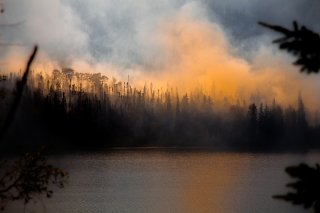
Wildfires in the Arctic are increasing in frequency and intensity due to climate change. Fire is a natural part of the Arctic landscape, but as temperatures rise and the land gets drier, it becomes easier for more intense fires to start. Since 2018, forest fires have tripled in some parts of the Arctic, and are expected to happen even in areas where they were uncommon before.14 Fires can be especially intense in peatland, where they can smolder for a long time, producing large amounts of smoke. The increase in frequency and intensity of wildfires in the Arctic is dangerous for people, ecosystems, and buildings. Wildfires also make overall warming worse by producing carbon in multiple forms, including black carbon.15
Precipitation Changes
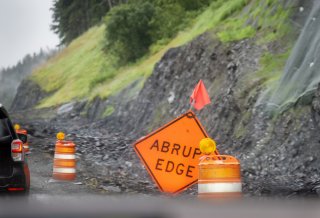
Precipitation in the Arctic is changing a lot due to climate change. Generally, annual and seasonal precipitation are increasing in Alaska.16 As temperatures rise, more precipitation is falling as rain than snow. There are also more extreme precipitation events, like heavy rainstorms.17 These can trigger landslides, flooding, and erosion. Heavy rainfall can also speed up permafrost thaw, contributing to further warming through carbon dioxide and methane emissions.18 Warmer temperatures and changing precipitation patterns have also affected the seasonal patterns of plants and animals and are making it harder for people to hunt for food.19
Warmer, More Acidic Oceans
Marine Heat Waves
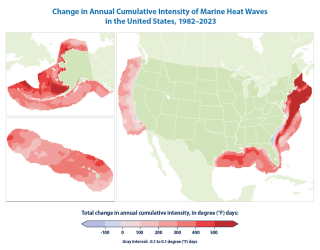
A marine heat wave happens when the sea surface temperatures in a region are much hotter than normal for that place and time of year. Marine heat waves are extreme events that can seriously harm marine ecosystems and have been happening more often as a result of climate change.20 Animals like corals, which can’t move, have a hard time surviving these high temperatures.21 Marine heat waves lead to less biological productivity, shifts in seasonal productivity, major changes in food web dynamics and big drops in food sources.
Over the past several years, Alaska has experienced more frequent and severe marine heat waves, with extreme temperatures lasting for years in some areas. Heatwaves can affect the marine environment all year, but they are usually most intense in summer and fall.22
Learn more about EPA's Marine Heat Waves Climate Change Indicator.
Ocean Acidification
Alaska has some of the highest rates of ocean acidification in the world, which can harm marine ecosystems.23 As atmospheric concentrations of carbon dioxide rise, the ocean absorbs more carbon dioxide, which reacts with sea water to produce carbonic acid. Higher levels of carbonic acid increases the acidity (measured by lower pH values) of the water, changing the balance of minerals. This can make it more difficult for corals, some types of plankton, and other creatures to make calcium carbonate, which is the main ingredient in their hard skeletons or shells.24 Ocean acidification can lead to big changes in ocean and coastal ecosystems, affecting the people who depend on them. It can affect Alaskan fish and shellfish species that are important for commercial and subsistence fishing.25
Learn more about EPA's Ocean Acidity Climate Change Indicator.
References
1 Meredith, M., M. Sommerkorn, S. Cassotta, et al. (2019). Ch. 3. Polar regions. In: IPCC Special Report on the Ocean and Cryosphere in a Changing Climate. H.-O. Pörtner, D.C. Roberts, V. Masson-Delmotte, et al., Eds. Cambridge University Press. https://doi.org/10.1017/9781009157964.005, pp. 203-320.
2 EPA. (2024). Climate Change Indicators: Arctic Sea Ice. Accessed December 11, 2024 https://www.epa.gov/climate-indicators/climate-change-indicators-arctic-sea-ice
3 IPCC (Intergovernmental Panel on Climate Change). (2019). Summary for policymakers. In: The ocean and cryosphere in a changing climate: Special report of the Intergovernmental Panel on Climate Change. Cambridge University Press. https://doi.org/10.1017/9781009157964.001
4 Osterkamp, T. E., and M. T. Jorgenson. (2009). Permafrost conditions and processes. In: R. Young and L. Norby, Geological Monitoring. Geological Society of America. https://doi.org/10.1130/2009.monitoring(09)
5 Arctic Monitoring and Assessment Programme (AMAP). (2017). Snow, Water, Ice and Permafrost in the Arctic. Summary for policy-makers. Oslo, Norway.
6 Meredith, M., M. Sommerkorn, S. Cassotta, et al. (2019). Ch. 3. Polar regions. In: IPCC Special Report on the Ocean and Cryosphere in a Changing Climate. H.-O. Pörtner, D.C. Roberts, V. Masson-Delmotte, et al., Eds. Cambridge University Press. https://doi.org/10.1017/9781009157964.005, pp. 203-320.
7 EPA. (2024). Climate Change Indicators: Freeze-Thaw Conditions. Accessed December 11, 2024 https://www.epa.gov/climate-indicators/climate-change-indicators-freeze-thaw-conditions
8 EPA. (2024). Community Connection: Ice Breakup in Three Alaskan Rivers. Accessed December 11, 2024 https://www.epa.gov/climate-indicators/alaskan-rivers
9 U.S. Department of Agriculture (USDA) Climate Hubs. (no date). Alaska and a Changing Climate. Accessed December 11, 2024 from https://www.climatehubs.usda.gov/hubs/northwest/topic/alaska-and-changing-climate
10 AMAP. (2017). Snow, Water, Ice and Permafrost in the Arctic. Summary for policy-makers. Oslo, Norway.
11 EPA. (2024). Climate Change Indicators: Ice Sheets. Accessed December 11, 2024 from: https://www.epa.gov/climate-indicators/climate-change-indicators-ice-sheets
12 AMAP. (2017). Snow, Water, Ice and Permafrost in the Arctic. Summary for policy-makers. Oslo, Norway.
13 AMAP. (2019). AMAP Climate Change Update 2019: An Update to Key Findings of Snow, Water, Ice and Permafrost in the Arctic (SWIPA) 2017. https://www.amap.no/documents/doc/AMAP-Climate-Change-Update-2019/1761
14 Arctic Council. (no date). Wildland Fire. Accessed December 11, 2024, https://arctic-council.org/explore/topics/climate/wildland-fire/
15 Arctic Council. (no date). Wildland Fire. Accessed December 11, 2024, https://arctic-council.org/explore/topics/climate/wildland-fire/
16 Jay, A.K., A.R. Crimmins, C.W. Avery, T.A. Dahl, R.S. Dodder, B.D. Hamlington, A. Lustig, K. Marvel, P.A. Méndez-Lazaro, M.S. Osler, A. Terando, E.S. Weeks, and A. Zycherman, 2023: Ch. 1. Overview: Understanding risks, impacts, and responses. In: Fifth National Climate Assessment. Crimmins, A.R., C.W. Avery, D.R. Easterling, K.E. Kunkel, B.C. Stewart, and T.K. Maycock, Eds. U.S. Global Change Research Program, Washington, DC, USA. https://doi.org/10.7930/NCA5.2023.CH1
17 Huntington, H.P., C. Strawhacker, J. Falke, E.M. Ward, L. Behnken, T.N. Curry, A.C. Herrmann, C.U. Itchuaqiyaq, J.S. Littell, E.A. Logerwell, D. Meeker, J.R. Overbeck, D.L. Peter, R. Pincus, A.A. Quintyne, S.F. Trainor, and S.A. Yoder, 2023: Ch. 29. Alaska. In: Fifth National Climate Assessment. Crimmins, A.R., C.W. Avery, D.R. Easterling, K.E. Kunkel, B.C. Stewart, and T.K. Maycock, Eds. U.S. Global Change Research Program, Washington, DC, USA. https://doi.org/10.7930/NCA5.2023.CH29
18 USDA Climate Hubs. (no date). Alaska and a Changing Climate. Accessed December 11, 2024 https://www.climatehubs.usda.gov/hubs/northwest/topic/alaska-and-changing-climate
19 Huntington, H.P., et al. (2023). Ch. 29. Alaska. In: Fifth National Climate Assessment. Crimmins, A.R., C.W. Avery, D.R. Easterling, K.E. Kunkel, B.C. Stewart, and T.K. Maycock, Eds. U.S. Global Change Research Program, Washington, DC, USA, p. 21. https://doi.org/10.7930/NCA5.2023.CH29
20 Mills, K.E., E.B. Osborne, R.J. Bell, et al. (2023). Ch. 10. Ocean ecosystems and marine resources. In: Fifth National Climate Assessment. Crimmins, A.R., C.W. Avery, D.R. Easterling, et al., Eds. U.S. Global Change Research Program. https://doi.org/10.7930/NCA5.2023.CH10
21 EPA. (2024). Climate Change Indicators: Marine Heat Waves. Accessed December 11, 2024 https://www.epa.gov/climate-indicators/climate-change-indicators-marine-heat-waves
22 EPA. (2024). Climate Change Indicators: Marine Heat Waves. Accessed December 11, 2024 https://www.epa.gov/climate-indicators/climate-change-indicators-marine-heat-waves
23 Huntington, H.P., et al. (2023). Ch. 29. Alaska. In: Fifth National Climate Assessment. Crimmins, A.R., C.W. Avery, D.R. Easterling, et al., Eds. U.S. Global Change Research Program. https://doi.org/10.7930/NCA5.2023.CH29
24 EPA. (2024). Climate Change Indicators: Ocean Acidity. Accessed December 11, 2024 https://www.epa.gov/climate-indicators/climate-change-indicators-ocean-acidity
25 Huntington, et al. (2023). Ch. 29. Alaska. In: Fifth National Climate Assessment. U.S. Global Change Research Program. https://doi.org/10.7930/NCA5.2023.CH29

